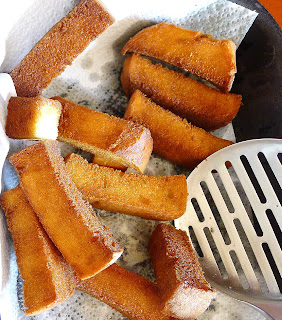When my two boys were growing up, the nearest neighbors in our valley were the Fernández family, with five kids. My two and those five ranged over the bancales (terraced land planted in fruit trees), down into the arroyo and occasionally up into the sierra behind the houses. Whether school day or weekend, promptly at 6 pm their mother emerged from the house to call, “Fernando!” (Fernando was the youngest of the clan.) “A merendar. Rocio! Tomi! Merienda!”
 |
| Call the kids! Merienda is served. |
For grown-ups, merienda is similar, but accompanied by café con leche or tea or, for workmen finishing a day’s labor, a small beer. Some cafés specialize in afternoon cakes and pastries especially for the merienda.
Industrial bollería—varying degrees of packaged junk food—has replaced much of the locally made rolls, buns, cookies and small sandwiches. But some old-fashioned meriendas still appear, in homes and cafés. Picatostes is one such. Picatostes are pieces of fried bread. They can be savory, like croutons, or sugared.
 |
| For merienda, a plate of crunchy fried bread dredged in sugar to go with drinking chocolate. |
One version of picatostes is identical to torrijas—the favorite dessert for Holy Week and Easter. Torrijas are slices of stale bread dipped in milk (or sweet wine), then egg and fried, Somewhat like French toast, they are sprinkled with sugar or drizzled with syrup. But the version I like best is nothing more complicated than sticks of fried bread, dredged in sugar. Much like churros, they are just made for dunking in thick, hot chocolate.
The thick chocolate, called chocolate a la taza, can be prepared from bars or granules of chocolate that come with sweetening and with starch for thickening. If you’re making the chocolate from scratch see this recipe for Hot Drinking Chocolate.
 |
| My son Ben and grandson Leo, enjoying chocolate con picatostes for afternoon merienda. |
 |
| Picatostes are just made for dunking! |
 |
| Picatostes are crunchy and sweet. |
 |
| This hot chocolate is almost as thick as pudding. |
 |
| Dip strawberries in the chocolate too! |
Sweet and Crunchy Fried Bread
Picatostes
Picatostes
 |
| Cut sandwich loaf into thick strips. |
The strips of bread can be cut in advance of frying. Seal them in a plastic bag until ready to use.
After frying and cooling, the picatostes can be stored in an air-tight container. They will stay crisp a few days.
Olive oil for frying (about 4 cups)
½ cup sugar
Cinnamon (optional)
To serve: Thick drinking chocolate or honey
Fruit as an accompaniment
Cut the bread crosswise into 1-inch slices. Cut the slices into thick strips.
Heat the oil in a deep skillet until it is shimmering. Have ready a plate with paper towels and a tray with the sugar.
 |
| Fry bread in olive oil until golden. |
Fry the strips of bread in batches, turning them as they become golden-brown. They’re ready in 2 minutes. Remove with tongs or skimmer and drain briefly on paper towels.(When cool, olive can be strained and used again.)
 |
| Drain the picatostes on paper towels. |
 |
| Dredge in sugar. |
Dredge the fried bread in sugar while it is still warm. Let the picatostes cool. Sprinkle with cinnamon, if desired.
Serve the picatostes with thick, hot chocolate for dipping. Or, drizzle them with honey that has been boiled with a little water. Accompany the picastostes with fruit.
 |
| Hot chocolate is as thick as pudding! |
Savory fried bread (croutons): Chickpea Puree with Crisp Croutons.
More merienda recipes:
Lemon-Scented Tea Cakes (Magdalenas).
Mallorcan Sweet Rolls (Ensaimadas).
Crisply Olive Oil Cookies.
Spanish Sandwiches.































